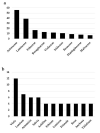Edible Flowers Used in Some Countries of the Mediterranean Basin: An Ethnobotanical Overview
- PMID: 36501312
- PMCID: PMC9736219
- DOI: 10.3390/plants11233272
Edible Flowers Used in Some Countries of the Mediterranean Basin: An Ethnobotanical Overview
Abstract
Edible flowers are becoming an essential component of people's nutrition in the Mediterranean basin. In the last decades, many researchers also have focused their attention on the nutritional composition of the edible flowers, as well as their antioxidant and antimicrobial properties, including studies on their safety issues. Despite the growing interest in the use of flowers in human nutrition, the ethnobotanical literature is lacking coverage of some important issues, particularly those which concern the use of flowers in the folk tradition. Only recently, a review regarding the contribution of 32 edible flowers to the Mediterranean diet was published. The aim of the present review is to document the plant lore regarding the wild and cultivated edible flowers consumed in the Mediterranean basin. Based on the 112 studies reviewed, we documented 251 taxa as being used in the Mediterranean basin as edible flowers. The plant species belong to 45 families and 141 genera. Asteraceae (54 taxa) is the most frequently cited family. Sambucus nigra L. is the most cited species. This study can be the basis for future research on the supposed bioactivity and toxicity of wild and cultivated flowers.
Keywords: antioxidant activity; aroma; bioactive compounds; diet; food plants; food system; new foods; nutrition.
Conflict of interest statement
The authors declare no conflict of interest.
Figures
References
-
- Demasi S., Caser M., Donno D., Enri S.R., Lonati M., Scariot V. Exploring Wild Edible Flowers as a Source of Bioactive Compounds: New Perspectives in Horticulture. Folia Hortic. 2021;33:27–48. doi: 10.2478/fhort-2021-0004. - DOI
-
- Mlcek J., Rop O. Fresh Edible Flowers of Ornamental Plants—A New Source of Nutraceutical Foods. Trends Food Sci. Technol. 2011;22:561–569. doi: 10.1016/j.tifs.2011.04.006. - DOI
-
- Newman M., Kirker C.L. Edible Flowers: A Global History. Reaktion Books; London, UK: 2016.
Publication types
LinkOut - more resources
Full Text Sources




